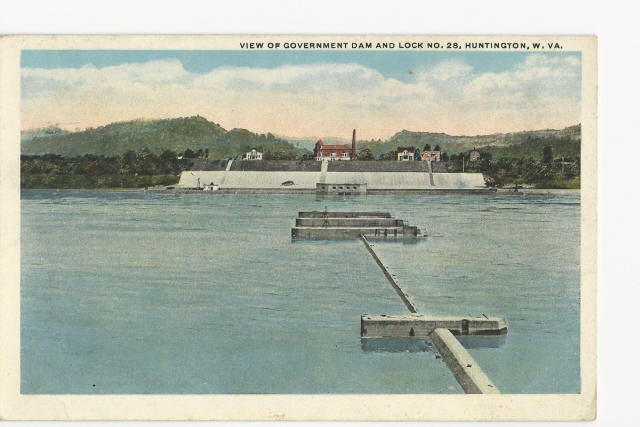
Lock and Dam No. 28
------------------------------------------------------------------------------------------------------

Courtesy of James E. Casto
----------
The old Ohio River Lock and Dam No. 28, as
seen from
Huntington bank of the river.
------------------------------------------------------------------------------------------------------
HUNTINGTON — When the first settlers arrived in the Ohio River Valley
they found a river that,
as one settler famously described it, seemed in some places “a mile wide and a
foot deep.”
Travel on the river was possible only when heavy rains or snow melt provided a
surge
of water. When steamboats debuted on the river, they often had to tie up
for days or even weeks awaiting a surge of high water.
Following the Civil War, river traffic - especially coal shipments -
dramatically multiplied.
After studying how to produce a reliable navigation depth on the Ohio,
the U.S. Army Corps of Engineers determined that building a system
of locks and dams to form pools of water was the best solution.
The 1895 construction of the Davis Island Lock and Dam on the Ohio at Avalon,
Pennsylvania,
proved the idea was workable, and so in 1910 Congress authorized construction of
50 small
locks and dams along the length of the river. Thanks to political bickering and
funding delays,
it was 1929 before all 50 were completed.
One of the 50 was Lock and Dam No. 28, located on the Ohio between West 26th
Street
in Huntington and the community of Sybene in Ohio, as shown in this
vintage postcard.
Beginning in the 1940s, as steamboats were replaced by powerful diesel-powered
towboats,
it became clear the network of small dams ultimately would need to be replaced
by larger
dams that would create longer and deeper navigable pools. And that’s exactly
what happened.
As new larger dams were built, the old dams were no longer needed and so were
demolished.
When the massive Greenup Locks and Dam was completed at Greenup, Kentucky, in
1962,
it eliminated any need for the four small dams located just upstream from it.
And so Dams No. 27, 28, 29 and 30 were demolished.
With the demolition of Dam 28, the facility’s former powerhouse
(the large red brick structure on the Ohio side of the river)
was turned into a senior center.
-----------------------------------------------------------
Note: This Article and picture appeared in the Herald-Dispatch Newspaper on June 8, 2014.
-----------------------------------------------------------
[ Back ]